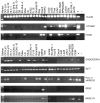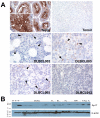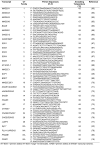A panel of cancer-testis genes exhibiting broad-spectrum expression in haematological malignancies
- PMID: 20726502
- PMCID: PMC2964014
A panel of cancer-testis genes exhibiting broad-spectrum expression in haematological malignancies
Abstract
Cancer-testis (CT) antigens/genes show restricted expression in normal tissues but widespread expression in many tumour types. This, coupled with their ability to induce cytotoxic T-lymphocyte responses, makes them attractive vaccine candidates. Following our identification of PASD1, we have used RT-PCR to analyse the mRNA expression profile of a large panel of CT genes in cell lines derived from haematological malignancies, and have studied Sp17 protein expression in the same cell lines and diffuse large B-cell lymphoma (DLBCL) biopsies. Our extensive analysis revealed multiple CT transcripts exhibiting widespread expression across cell lines derived from 21 B- and 4 T-cell malignancies. The broadest mRNA expression profiles were observed for the following eight CT genes: Sp17 (25/25), PRAME (25/25), CSAGE (24/25), PASD1 (22/25), CAGE/DDX53 (19/25), CTAGE1 (19/25), HAGE/DDX43 (16/25) and PLU-1/JARID1B (15/25). Cell lines derived from more aggressive lymphoma subtypes generally expressed CT transcripts at higher frequency. Sp17 protein was detected in a number of cell lines and in six of eleven (54.5%) DLBCL biopsies. Analysis of Sp17 protein expression, by immunohistochemistry and Western blotting, broadens the scope of this CT antigen as a potentially relevant clinical target in haematological malignancies. Further studies of protein expression are now needed to validate these antigens as vaccine candidates.
Figures







Similar articles
-
Combined real time PCR and immunohistochemical evaluation of sperm protein 17 as a cancer-testis antigen.Eur J Haematol. 2004 Oct;73(4):280-4. doi: 10.1111/j.1600-0609.2004.00308.x. Eur J Haematol. 2004. PMID: 15347315
-
Cancer-testis antigens in haematological malignancies.Br J Haematol. 2007 Mar;136(6):769-76. doi: 10.1111/j.1365-2141.2006.06484.x. Br J Haematol. 2007. PMID: 17223912 Review.
-
A novel diffuse large B-cell lymphoma-associated cancer testis antigen encoding a PAS domain protein.Br J Cancer. 2004 Jul 5;91(1):141-9. doi: 10.1038/sj.bjc.6601875. Br J Cancer. 2004. PMID: 15162151 Free PMC article.
-
A yeast two-hybrid system using Sp17 identified Ropporin as a novel cancer-testis antigen in hematologic malignancies.Int J Cancer. 2007 Oct 1;121(7):1507-11. doi: 10.1002/ijc.22842. Int J Cancer. 2007. PMID: 17551920
-
The cancer/testis genes: review, standardization, and commentary.Cancer Immun. 2004 Jan 23;4:1. Cancer Immun. 2004. PMID: 14738373 Review.
Cited by
-
Structure-Based, Rational Design of T Cell Receptors.Front Immunol. 2013 Sep 12;4:268. doi: 10.3389/fimmu.2013.00268. Front Immunol. 2013. PMID: 24062738 Free PMC article. Review.
-
miR-200b and cancer/testis antigen CAGE form a feedback loop to regulate the invasion and tumorigenic and angiogenic responses of a cancer cell line to microtubule-targeting drugs.J Biol Chem. 2013 Dec 20;288(51):36502-18. doi: 10.1074/jbc.M113.502047. Epub 2013 Oct 30. J Biol Chem. 2013. PMID: 24174534 Free PMC article.
-
miR-30a Regulates the Expression of CAGE and p53 and Regulates the Response to Anti-Cancer Drugs.Mol Cells. 2016 Apr 30;39(4):299-309. doi: 10.14348/molcells.2016.2242. Epub 2016 Feb 25. Mol Cells. 2016. PMID: 26912082 Free PMC article.
-
Cancer/Testis Antigen PASD1 Silences the Circadian Clock.Mol Cell. 2015 Jun 4;58(5):743-54. doi: 10.1016/j.molcel.2015.03.031. Epub 2015 Apr 30. Mol Cell. 2015. PMID: 25936801 Free PMC article.
-
Epigenetic Regulation by Lysine Demethylase 5 (KDM5) Enzymes in Cancer.Cancers (Basel). 2011 Mar 1;3(1):1383-404. doi: 10.3390/cancers3011383. Cancers (Basel). 2011. PMID: 21544224 Free PMC article.
References
-
- Ng AK. Diffuse large B-cell lymphoma. Semin Radiat Oncol. 2007;17:169–175. - PubMed
-
- Weigert O, Unterhalt M, Hiddemann W, Dreyling M. Current management of mantle cell lymphoma. Drugs. 2007;67:1689–1702. - PubMed
-
- Richardson PG, Mitsiades C, Schlossman R, Munshi N, Anderson K. New drugs for myeloma. Oncologist. 2007;12:664–689. - PubMed
-
- Harris NL, Jaffe ES, Diebold J, Flandrin G, Muller-Hermelink HK, Vardiman J, Lister TA, Bloomfield CD. The World Health Organization classification of neoplastic diseases of the hematopoietic and lymphoid tissues. Report of the Clinical Advisory Committee meeting, Airlie House, Virginia, November, 1997. Ann Oncol. 1999;10:1419–1432. - PubMed
-
- Horning SJ, Rosenberg SA. The natural history of initially untreated low-grade non-Hodgkin's lymphomas. N Engl J Med. 1984;311:1471–1475. - PubMed
Publication types
MeSH terms
LinkOut - more resources
Full Text Sources
Medical
